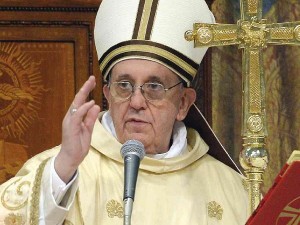
ROME—In his first public Mass as the new head of the Roman Catholic Church, Pope Francis signaled a striking liturgical difference with Pope Emeritus Benedict XVI by facing the people, not turning his back, which the retired Pontiff had done in a controversial attempt to bring back the Latin Mass banished by Vatican II.
In his inaugural Mass with the 114 cardinals who elected him in a conclave on Wednesday, Pope Francis, formerly Cardinal Jorge Mario Bergoglio, archbishop of Buenos Aires, Argentina, also used a small minimalist crucifix, contrary to the usual practice of the former papacy where huge baroque crucifixes were used.
Although hardly noticed by those who attended the Mass, the differences were striking and dramatic for those in the know.
Benedict, even when he was Cardinal Joseph Ratzinger, the doctrinal watchdog of Pope John Paul II, opposed the popular liturgical reforms of Vatican II, calling them excessive and a misreading of Sacrosanctum Concilium, the first document to come out of the council in 1963, better known by its descriptive title, Constitution on Liturgy.
The liturgical charter called for the people’s active participation in the Mass as well as the translation of the Roman rite into the vernacular. Pope Paul VI, who implemented the council’s reforms, later banned the Tridentine or Latin Mass, the Mass that was approved by the Council of Trent in the 16th century, the council that reformed the Church against the Protestant threat.
As a result of the reforms and in order to better popularize the Mass, the priest was made to face the congregation, not the altar, as had been the practice for hundreds of years. The reforms also led to the cultural adaptation of the Mass, including the incorporation of pop and rock songs in some local liturgies.
‘Eucharistic import’
But Ratzinger said the innovations were a misreading of the Constitution on Liturgy. He said the priest in the old Latin rite was facing the altar because as priest, he was leading with the people the memorial of the sacrifice of the Mass. He added that for the priest to face the people would be tantamount to making the Mass a congregation or, worse, a concert, which misses the “Eucharistic import” of the liturgy.
In theological language, Pope Benedict XVI in all of his Sistine Chapel Masses, amid the dramatic frescoes of Michelangelo depicting the history of salvation, faced the altar ad orientam or “toward the East,” to denote the sacrifice of the Mass and the promise of resurrection, hence the east where the sun rises every morning.
For the priest to do the Mass ad populum, or “toward the people,” would be to lessen the import of the Mass as the sacrifice of Christ, Benedict said.
Benedict likewise used huge crucifixes in his Masses to emphasize the “christological dimension” of the Mass as the sacrifice of God the Son to redeem mankind from sin.
‘Apostasy’
Benedict also opposed the cultural adaptation of the Latin rite and the banishment of the Latin Mass. He called some culturally adapted liturgies, such as the incorporation of popular songs in the Mass, “a form of apostasy.”
He said vernacular translations of the Mass should hew as closely as possible to the Latin original. As a result, Benedict ordered the English translation changed.
“Et cum spiritu tuo,” the Latin response to the greeting of the priest, “Dominus vobiscum (The Lord be with you),” which had been translated in the immediate aftermath of Vatican II as “And also with you,” is rendered now as “And with your spirit.”
The use of the vernacular and the adaptation of popular cultural forms in the Mass has been criticized by traditionalists, who complain that they cannot recognize anymore the old beauty of the Latin Mass from its hybrid, innovated forms.
Roman Missal
But respecting his predecessors while sticking to his guns regarding the “organic development” of the liturgy, Pope Benedict XVI issued Summorum Pontificum in 2007, upholding the Roman Missal as vernacularized in various forms and promulgated by Pope Paul VI, as the “ordinary expression” of the law of prayer of the Church.
But the same decree also ruled that the Roman Missal promulgated by St. Pius V after the Council of Trent and reissued by Blessed John XXII in the 1960s is the “extraordinary expression” of the same law of prayer and should be given the proper honor.
In plain language, while Popes since Paul VI banished the Latin Mass and allowed its celebration only if it had clearance from the local bishop, Benedict resurrected it and allowed its celebration even without permission from the bishops.
Despite the striking difference in the Sistine Mass of the new Pope from the ones celebrated by his predecessor, in the same venue, Thursday’s Mass still reserved kneelers at the altar, indicating that Pope Francis may yet follow the example of Benedict in offering the Mass ad orientam.
Witness to Christ
In addition, Francis echoed Benedict’s frequent call for the Church to go back to its roots.
He urged the cardinals to shun modern temptations and stick to the basics of the faith.
Like Benedict, Francis said the Church should be witness to Christ despite the challenges and the criticisms leveled against it by the modern world.
“If we do not confess to Christ, what would we be? We would end up a pitiful NGO. What would happen would be like when children make sand castles. And then it all falls down,” Francis said.
The new Pope said the faithful must walk the way of the cross.
“We can walk all we want, we can build many things, but if we do not proclaim Jesus Christ, the thing is not going to work,” he said.